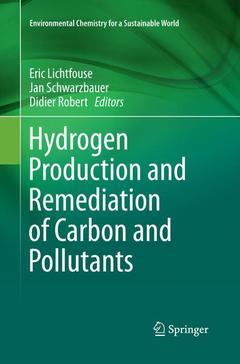Hydrogen Production and Remediation of Carbon and Pollutants, Softcover reprint of the original 1st ed. 2015 Environmental Chemistry for a Sustainable World Series, Vol. 6

This book details first the chemistry of hydrogen production from biomass. Solutions to the CO2 issue are given in three chapters, which describe CO2 photo catalytic reduction, CO2 sequestration in terrestrial biomass, and plants as renewable fuels. Further chapters review the selenium cycle in ecosystems, advanced processes to treat water and ecological ways to dye textiles.
Society growth during the last century has almost entirely relied on the carbon economy, which is the use of fossil fuels for energy and materials. The carbon economy has provided and will still provide many benefits. However, the increasing use of fossil fuels is partly responsible for the increase of atmospheric CO2 concentrations and in turn, global warming. There is therefore an urgent need for cleaner fuels such as hydrogen, as well as a need for a carbon neutral economy where each emitted CO2 molecule is fast sequestered in plants, algae, soils, sub soils and sediments.
Dr. Eric Lichtfouse is Editor of scholarly journals and series in environmental chemistry and agriculture. He teaching scientific writing in Europe and the USA and is heading publication assistance services. He has done research in organic geochemistry, soil carbon dynamics and phytoremediation. He is the author of the book ‘Scientific Writing for Impact Factor Journals’.
Dr. Jan Schwarzbauer is Editor of the journal 'Environmental Earth Sciences' and Subject Editor of 'Journal of Soils and Sediments'. After studying chemistry at the University of Hamburg, he is working since 1998 at the RWTH Aachen University leading as full professor the group 'Environmental Organic Geochemistry'.
Dr. Didier Robert is professor in organic chemistry and green chemistry at the University of Lorraine-Metz (France). He is associate editor of the Journal of Photocatalysis Sciences and its research activities are devoted to the decontamination of air and water by photochemical processes, especially by photocatalysis.
Date de parution : 10-2016
Ouvrage de 290 p.
15.5x23.5 cm
Date de parution : 09-2015
Ouvrage de 290 p.
15.5x23.5 cm



